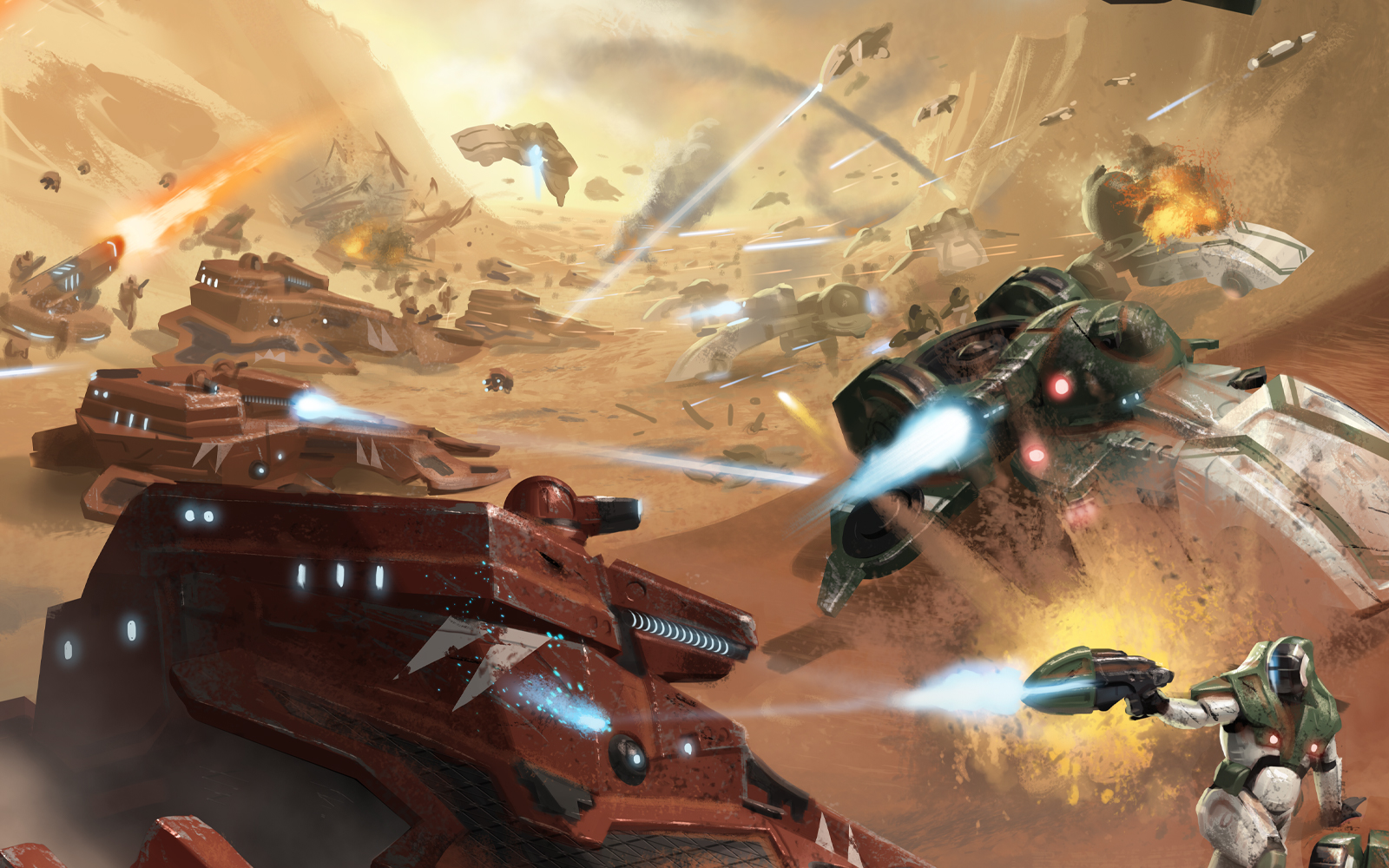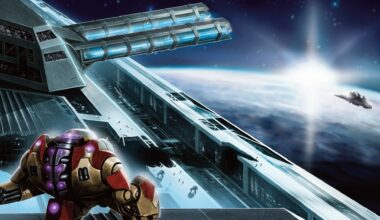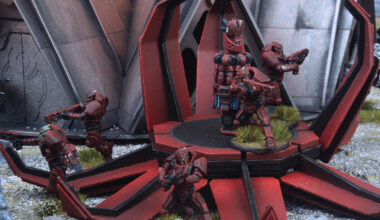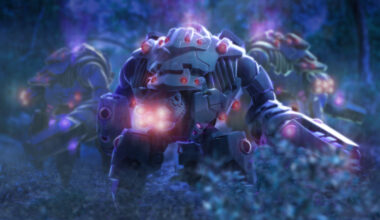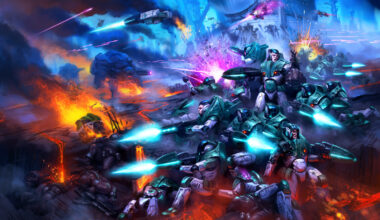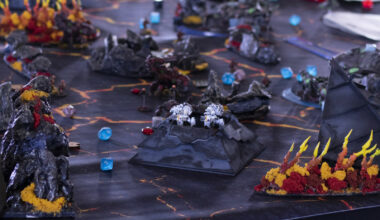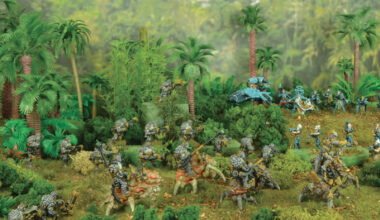In the last instalment, we ran through a brief overview of the Warring Ages (the Antares 5th Age of PanHumanity) and put into context one of the most war-ridden eras of panhumanity. This instalment we introduce the major peoples and civilisations that played a part in the constant stream of warfare.
Note: Antarean dates are given in the format <age>A<common_year>, where <age> is 1A, 2A, 3A, and so on up to 7A for the Seventh Age, and the <common_year> is the generally agreed, standard Old Earth year after the Age was established. This is often from where gates first began to reopen, but could be from the emergence onto Antares of an influential system, such as Isor in the 7th Age. The collapses are in the same format but with ‘AC’, such as ‘5AC10’.
Conflict and Scarcity
The 4th Collapse was harsh to panhumans almost everywhere. Though it lasted only hundreds of years for many, those systems which were not well-established or which lost the import of advanced goods and resources found themselves rapidly sinking into barbarism and losing their technological advantages. A few of the more advanced systems managed to retain their technology but in many others energy weapons were replaced by mag weapons, mag was replaced by chemical or pressure weapons, and on the harsher worlds – those that were not fully terraformed – humanity regressed to barbarism, reliant on more primitive electricity or even regressed further back to become reliant on nature, water and wind for power.
Even fossil fuels were hard to come by on those worlds that lacked the millions of years of local evolution. More than any other age, the Fourth Age collapse drove home how many settled worlds had been terraformed in some fashion, not just by panhumanity by in earlier ages, whether by a previous, long-lost civilisation or even the Gatebuilders. On many worlds, what technology was retained became precious items, carefully maintained or jury-rigged by those engineers that survived; on some, the engineers, or those who controlled the remaining, precious resources, grew to be an elite.
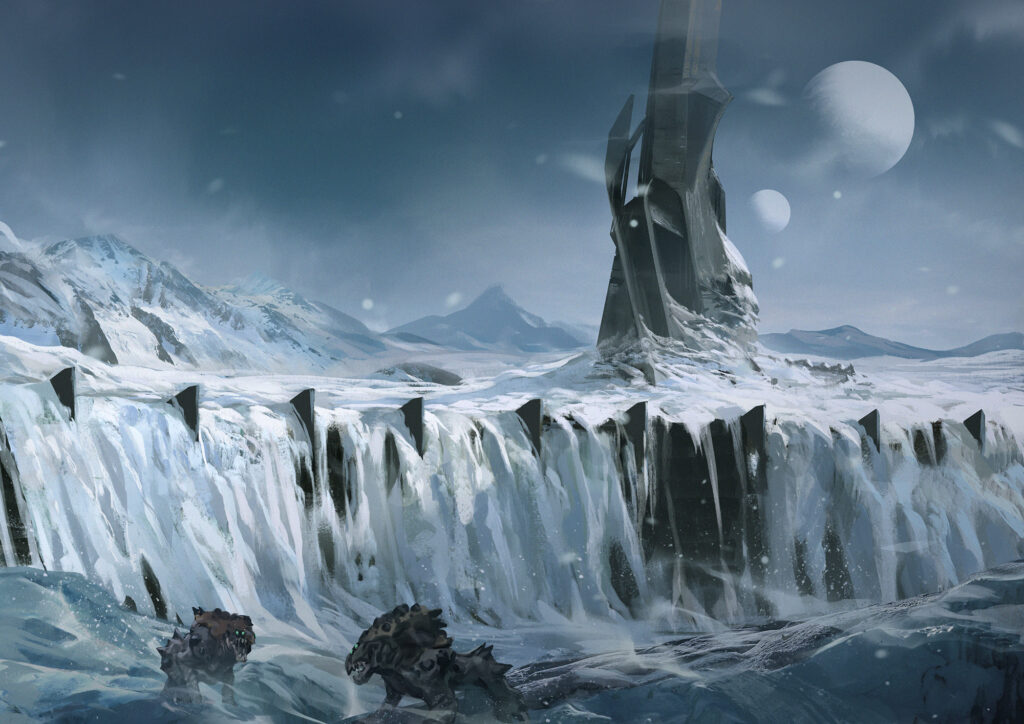
Fleets of spaceships were mothballed, the systems having little need or appetite for interstellar travel, focusing on transports to maintain the mines on moons, asteroids and similar facilities around their system. Orbitals were abandoned as the lack of maintenance made them hazardous, though it was rumoured a few of the largest with access to mineral-rich planets were able to survive the long centuries of isolation.
For others, it was the lack of knowledge, training and equipment that forced their regression. This was especially keen where databanks collapsed due to a lack of power or the knowledge to keep them in operation. Across the many worlds of panhumanity it was a long, dark struggle, where technology regressed and local feudalism grew. Those few living on moons and orbitals who were still able to retain spaceflight and maintain their habitats considered themselves lucky, but even they found themselves regressing after equipment – perhaps inevitably – irretrievably broke. Such systems kept a close eye on the gate horizon, ever hoping that they would be reconnected to Antares, but never knowing where or when the gate would appear.
Survivors and Mutatations
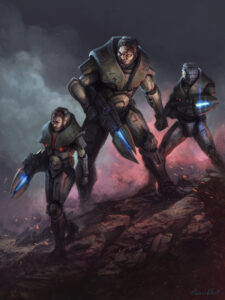
Mutations and adaptations become a feature of this collapse and led to much of the variety in panhuman morphs we see in the 7th Age. The Krasz are said to have evolved – or been evolved – during this time, some pointing out that the prehistoric planet of Kras was the home of a Xon Empire research and genetics laboratory. Being isolated for several thousand years helped the mutation and growth of the rough-and-ready Krasz culture though was not conducive to the frail NuHu! There is also strong evidence to suggest that the 4th Collapse was when the Algoryn were forced to mutate (or consciously adapt) to cope with the output from their twin suns, Enbris and Onebris. It appears the Gyohn appeared during the 4th Collapse as a result of an infection created by the NuHu of the successor Xon states: it was intended to create hardier soldiers but failed to get a firm foothold before the collapse. The isolation fixed the adaptation into the Gyohn genes across the planet, though it appears the original infection was deliberately engineered to have a short life. The only panhumans who, as a whole, appeared to suffer less than others were the NuHu and the Boromites. The children of Borom, with typical stoicism and forbearance, settled in the systems in which they found themselves and exploited all the resources they could mine. But even the Boromites were hard-pushed to develop their technology beyond that of the 4th Age. Like others, they were deprived of vital elements and manufacturing facilities and focused on maintaining what ships, habitats and technology they had carried with them.
The NuHu found their power enhanced by the lack of technology around them. Though in many places they suffered without immersion in a nanosphere, their expansive memory capacity and ability to see into a problem meant they became the keepers of knowledge. Even when retained or heralded as advisors, those worlds with a clan of NuHu considered themselves fortunate, even when the NuHu were the real power behind the ruling dynasties.
The Reopening – the Fight for Survival
Gates were slowly reopened at the start of the 5th Age, as if Antares were and Obureg were struggling to reopen the gates. No-one knows exactly which systems were first reopened as, with no nearby neighbours, those worlds lacking spaceflight would not be discovered until sometime later.
Of course, amongst the millions of systems connected to Antares, not all regressed. However, those comparatively few systems retaining spaceflight found themselves forced to make long journeys to find gates and even they were desperate to find resources and people. Almost inevitably, the systems who had regressed found themselves easy prey to the starfarers: unable to prevent the exploitation of their system and unable to resist the military might of the off-worlders, the locals were forced into servitude. In a pattern that was to be repeated in subsequent ages, those worlds who did not have the wherewithal to pay for off-world goods had to trade what little they had – chiefly people, much like the Ferals of the 7th Age.
A few of the more civilised worlds tried to establish mutually-beneficial political relationships, but with the backward worlds so far behind, it was often a one-side relationship. Within a century, even the benevolent systems were becoming stretched in defending their less-fortunate members and adopted a mutual-defence model that insisted on all resources – even panhuman – being used in the defence of the small empires that they had become. In many cases the more advanced empires were led by NuHu enclaves or families who still dreamt of re-establishing the dominance they had experienced in the Xon Times.
But co-operation between such powerful centres of civilisation was minimal and expansion, with the lack of civilisation, slowed. It seemed that Antares was focusing on merely reconnecting those systems that contained panhuman life, not those systems that might have plentiful resources.
So the battle between the empires for control of resources and personnel intensified, becoming increasingly bitter for over 600 years. Countless minor empires and fiefdoms rose and fell, each based largely on a feudal model of subservience. The more benevolent empires included numerous protectorates, the Gethdereh Trade Federation, the Alzanthan Alliance (a precursor to the 6th Age Alzanthan Federation), and the NuHu-dominated League of Ha’Ruul; the notably more harsh empires included the Kerodh Despotate, the Kingdom of Ehren-Tze led by the tyrant NuHu family of the same name, many minor empires – Senn, Idess and Yohm being the most barbaric – and the military dictatorship disguised as the Saviours of Teveron.
In addition, there were dozens of raider fleets that plagued benevolent and despotic empires alike. These existed by constantly moving, never staying in a system more than the time required to make repairs, and even resorting to node piracy – the waylaying and capture of shipping at low-velocity nodes such as planetary destinations of gate horizons.
Why Empire and Feudalism?
As mentioned in in the last article, Fifth Age intra-system travel is much slower than that of the 7th Age. Even the reasonably well-maintained ships were limited (if that is the word!) to usable thrusts of 6G. Further, without the extensive shields and drive fields of the Isorian drive, the ships were a little smaller than 7th Age ships.
For a G2 star like Old Sol, trading ships might take 9 days to travel from the gate horizon to habitable planets and even combat ships at between 12G to 18G would take half that time. On the Antarean surface, a 5th Age cruise liner (not that there were many!) would take around 10 hours subjective, and 2.3 days elapsed to travel from one subhex to another – a little less than average gate distance – whilst a high-end 5th Age military ship would take 7.5 hours subjective (1.8 days elapsed). Added to this was the transit time (time within the gate) which, in the Warring Age had a tendency to be longer than in other ages, with 2-3 days not being uncommon.
It is thought the length Transit time was due to the strange way that Obureg behaved at the end of the Xon Times.
This lengthy period of at least two to three weeks from an inner planet to another in the closest system imposed a communications limit on co-ordination.* The lack of an IMTel, incompatible technology and often no nanosphere meant communications and control over a distance was severely limited. Hence this was a time of much devolved responsibility, where pledges of aid – or pacts of trust – were given in return for fealty, taxes and the provision of military assets when needed.
And in the Warring Ages, military assets were in great demand.
* 9-18 days intra-system travel, plus a total of 4 days in transit within the two gates, plus 2 days travel between the gates – if adjacent!
Return of the Vorl
The first Vorl were noticed around 610 years after the gates began to reappear. Initially, they were widely scattered around Antares and were regarded as little more than a nuisance – nothing like the threat they had been at the end of the Xon Times. Those who encountered them noticed a difference: the Vorl had taken a step back in technology and weaponry. Whether this regression was a conscious decisions or was due to the same problems the humans experienced was unknown.
During the 7th century the individual Vorl Ordo expanded in their usual fashion, picking on an alien or panhuman world, razing it of its inhabitants, and then taking time to establish a dependent clade of the Ordo. Where they encountered each other, which was rare, it was notable that co-operation was distinctly lacking, perhaps – again conjecture – due to the pressing shortage of resources.
The Ordo continued their expansion and by the mid 8th century the Vorl were starting to form larger concentrations, either due to a stabilisation of resources or because their internal conflicts had produced a dominant Ordo. Their attacks on the human empires began to be more focused, requiring a larger military commitment to defend and forcing the merge of the smaller empires. For two hundred years the human political landscape was one of consolidation.
Only then did the Vorl redouble their efforts. Surviving accounts suggest that a swathe of newly connected systems were Vorl controlled. These, coupled with the gradual domination of a single Ordo – the Third Claws – added significant military resources and the less advanced or poorly protected human worlds fell.
The pressure began to fragment and by the mid-tenth century, the various protectorates, empires, kingdoms and alliances. Worlds broke away from one federation for the promise of protection by another – only to find their new masters strip their planet of resources ‘for the war against the Vorl’ and send the conscripts to a front line. Except the front lines were often against other panhumans!
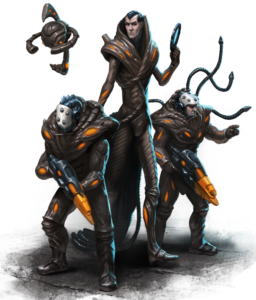
The Vorl continued their expansion until, round about 1100, a vast swathe of panhuman worlds across the equatorial regions decided to form the defensive confederation, the Ascendency. It is only now that the Vorl are kept in check and whilst the Ascendency sometimes wanes, in general its growth continues for over 600 years. In 1700, the Ascendency switches to a total war footing, turning its alliance into a military dictatorship, and by 1800 the Vorl find themselves pushed back. The dominance of the Third Claws Ordo collapsed and, once more, inter-Ordo conflict arose.
Ironically, it could be said it was the Vorl who brought stability to the panhuman worlds of Antares in the Warring Age. The stability was not to last very long: shortly after the Ascendency attacked the most advanced civilisation on Antares, the Isori, the Nexus suddenly collapsed!
Next Instalment: Factions
The range of panhuman and alien forces involved in the constant warfare of the 5th Age is staggering. Battlefields might see a wide range of technology from primitive chemical weapons and heavily armoured infantry through to wheeled, tracked and suspensored vehicles – without the deadly accuracy of the surrounding Ages, even aerial forces might be involved (though not against the advanced nations). Next instalment, we’ll go over some of the major factions mentioned here, as well as outlining how you, the Antares player, might want to dream up your own and in subsequent instalments, we’ll discuss how the weaponry and troops of the 5th Age can be represented on the tabletop.
